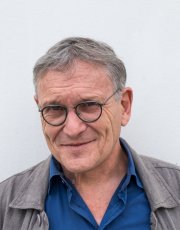
Rony Brauman

Medical doctor, specialized in tropical medicine and epidemiology. Involved in humanitarian action since 1977, he has been on numerous missions, mainly in contexts of armed conflicts and IDP situations. President of Médecins sans Frontières from 1982 to1994, he also teaches at the Humanitarian and Conflict Response Institute (HCRI) and is a regular contributor to Alternatives Economiques. He has published several books and articles, including "Guerre humanitaires ? Mensonges et Intox" (Textuel, 2018), "La Médecine Humanitaire" (PUF, 2010), "Penser dans l'urgence" (Editions du Seuil, 2006) and "Utopies Sanitaires" (Editions Le Pommier, 2000).
Introduction
Humanitarian medicine is made up of a wide range of practices with few obvious connections between them. Battlefield medicine and surgery, rural dispensaries in remote areas, campaigns to raise awareness about health problems in poor countries, emergency teams in disaster situations, vaccination campaigns, health education, help for marginalised groups in affluent countries and public health advice are just some examples of actions that fall within the scope of “humanitarian medicine” when they are carried out by organisations and in circumstances that can be classified as “humanitarian”. The field is defined not by a particular set of techniques but by the setting in which the action takes place and the stated aim of those involved. This may appear inadequate as a definition insofar as it combines some very different areas under a single heading, both from the point of view of the context in which the action takes place and the status of the organisations involved. Heterogeneity, however, is a defining characteristic of humanitarian medical practice and this is the reality I have opted to describe in empirical terms, focusing on its inherent diversity. Humanitarian interventions in conflict situations, for example, are based on the premise that those involved are independent of all political powers and consciously choose to stand apart from them. Public health programmes, by contrast, require a close relationship with the political authorities in the country where the programme is being implemented. Some forms of aid rely on direct assistance in the short or medium term, whilst others form part of structural policies, with no clear end-date; some concern tangible individual needs, whilst others are designed to change collective practices. And there is no shortage of situations where several of these categories apply at the same time. The word “humanitarian” is used in many different ways, which are sometimes inconsistent with each other, but which have achieved a degree of public recognition that I have chosen to respect. This book therefore covers a wide range of different forms of humanitarian medical practice, some of which involve major crisis situations, primarily armed conflict and natural disasters, whilst others relate to areas such as technical assistance for development, or health security.
Although they can all be labelled as “humanitarian”, these different forms of medical assistance are not all treated in the same way in this book. Some of them rely on specific know-how, built up through borrowing and innovation primarily over the last three decades, whilst others reflect a different way of using the knowledge we already have. The former are examined in relation to their specific context whilst the latter are described only in broad terms. This distinction does not in any way represent a moral judgement. It is justified by two reasons that are quite separate from any a priori assessment of the usefulness of one as opposed to the other. First, in my view this specific know-how is the real core of the medical aspect of humanitarian action; secondly and more importantly, it is new both in terms of medical practice and humanitarian practice. The wide variety of techniques and specialties that make up humanitarian medicine means it is impossible, in any event, to turn it an academic discipline that could be taught as such, like cardiology or obstetrics.
My personal experience and the collective experience of Médecins Sans Frontières (MSF), where I have spent most of my career, underpin my conception of humanitarian medicine. It is important to make this clear, because institutions working in this area vary in terms of how they operate and how they prioritise different issues, or in other words how they understand their respective roles and objectives. It is undoubtedly also worth adding that differences exist not only between organisations but also within them, resulting in frequent debates internally. This pluralism is one factor that will help to mitigate the influence of one specific approach to humanitarian action, namely that of MSF. Another is the author’s commitment to presenting the variety of practices found under the heading of humanitarian medicine. That said, this book has been written by an active participant rather than by a researcher, and will therefore examine both the medical relevance and political legitimacy of a particular experience where appropriate.
In order to understand what distinguishes and what unites the various forms of humanitarian medicine, it is worth taking the time to reflect on the circumstances of its emergence over time as a specific form of action, less for the sake of history as such than to shed light on and compare diverse practices that can be better understood in terms of their context and how they have changed from a historical perspective.
Période
Newsletter
Subscribe to our newsletter to stay informed about our latest publications. Interested in a specific author or thematic? Subscribe to our email alerts.
